8 Steps for Wonderful Winter Walks
January 20, 2025
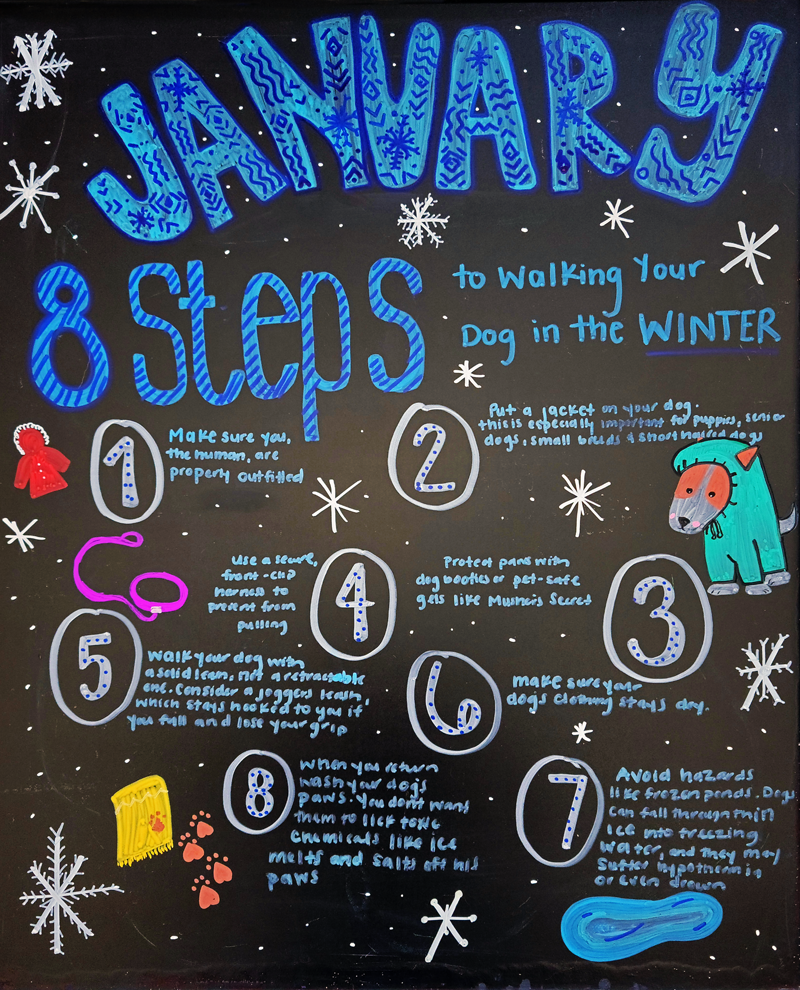
Keep You and Your Dog Fit (and Safe) on Winter Walks
In keeping with many New Year’s Resolutions to get healthier, January is National Walk Your Dog Month. It may seem like the worst time to get out into the great outdoors with your pet, but following these 8 steps will keep you both safe and warm.
- Make sure you, the human, are properly outfitted for the cold. Gloves are especially important when holding a leash!
- Put a jacket on your dog. This step is especially important for puppies, senior dogs, small breeds and short-haired dogs.
- Protect paws from ice and de-icing chemicals with dog booties or pet-safe gels like Musher’s Secret.
- Use a secure, front-clip harness to prevent your dog from pulling. This is safer for everyone in slippery conditions.
- Walk your dog with a fixed leash, not a retractible one. Consider a jogger’s leash, which stays hooked to you, if you fall and lose your grip.
- Make sure your dog’s clothing stays dry. Or cut your walk short if it becomes damp or wet.
- Avoid hazards like frozen ponds. Dogs can fall through thin ice into freezing water. They may suffer hypothermia or even drown.
- When you get back, wash your dog’s paws. This keeps them from licking toxic chemicals like ice melts and salts off of their paws.
Have fun exploring the winter scenery with your dog! But remember, if the weather is particularly nasty, wait until another day. Cuddling by the fire with your dog doesn’t burn calories, but it is good for the soul.
For more tips, check out our article, “Keep Your Pet Safe this Winter.”
Read More
National Train Your Dog Month
January 13, 2025
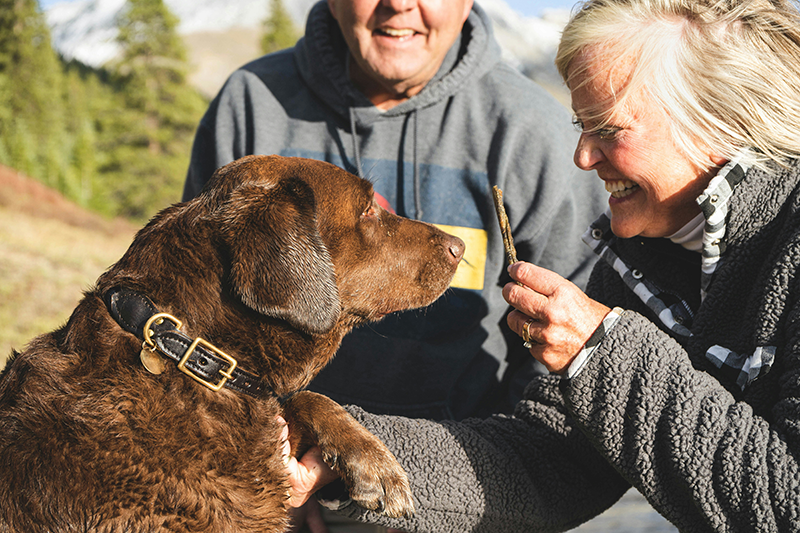
During January’s Cold, Spend Some Quality Time with Your Dog!
January is National Train Your Dog Month, and we can’t think of a better way to spend these cold winter days than indoors helping your dog become more social, well-adjusted and welcome anywhere they go.
And you know how they say you can’t teach an old dog new tricks? That’s not true! Obedience training is great for any age. In fact, most animal shelters are able to ready adult dogs for forever families through training.
Local Classes for National Train Your Dog Month
The best way to train your dog is with expert help. A professional dog trainer has experience with hundreds (thousands?) of dogs and will help personalize a program for you and your pup.
To get you started on your research, here are some places to check out. While these organizations have been recommended to us and/or have positive reviews, please use your own judgement about if a given trainer will be a good fit for your family.
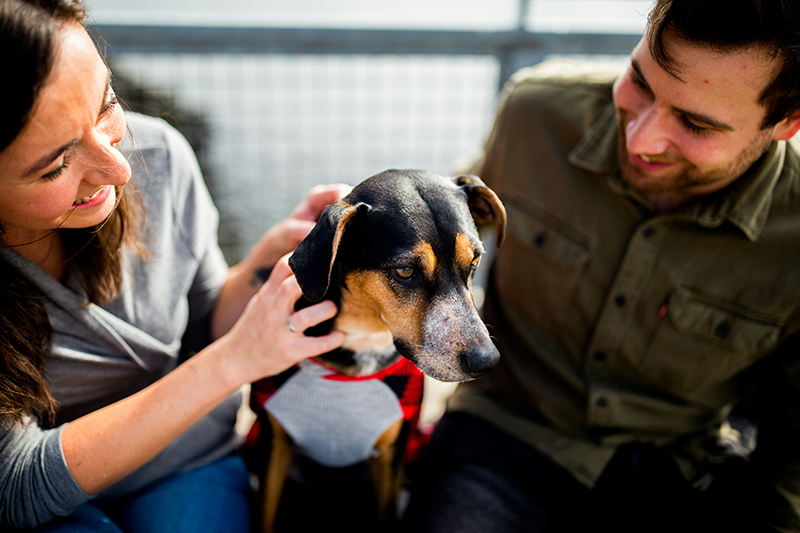
At-Home Resources for National Train Your Dog Month
If you’re just getting started and want to try some training at home, check out these resources.
Enjoy checking out these resources and helping your dog be their best selves!
Read More
Help Your Pet Have Safe & Healthy Holidays
December 20, 2024
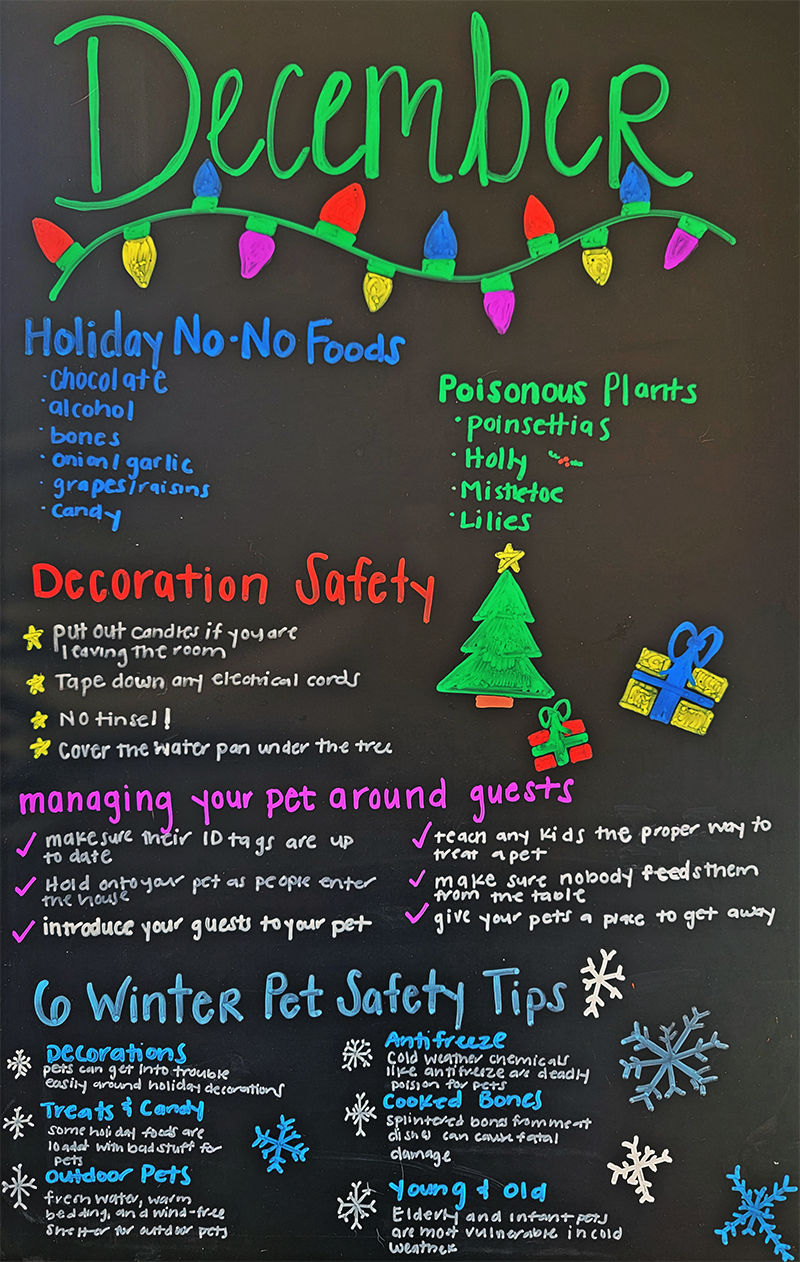
From Foods to Decorations to Guests, Follow These Tips this Season
Christmas, New Years and all the winter holidays can pose some challenges for keeping your pet safe. Keep these simple tips in mind for happy holidays.
Holiday No-No Foods
These foods are dangerous for pets and need to be kept away from them.
- Chocolate
- Alcohol
- Bones
- Onions
- Garlic
- Grapes/raisins
- Candy
- Cooked bones
Poisonous Plants
Festive Christmas plants can also be dangerous for curious pets. Consider artificial replacements for:
- Poinsettias
- Holly
- Mistletoe
- Lilies
Decoration Safety
Everyone loves beautiful holiday decorations! Follow these guidelines for decor that both people and animals can enjoy.
- Put out candles if you are leaving the room
- Tape down any electrical cords
- Avoid tinsel
- Cover the water pan under the Christmas tree
Managing Your Pet Around Guests
Help help your pets successfully interact with guests takes a little planning. Here are some ideas.
- Make sure their ID tags are up-to-date
- Hold onto your pet as people enter the house
- Introduce your guests to your pet
- Teach kids the proper way to treat a pet
- Make sure nobody feeds them from the table
- Give your pets a safe place to get away and have quiet time
Cold Weather Safety
- For outdoor pets, make sure to offer fresh (unfrozen) water, warm bedding and wind-free shelter
- Keep your pet away from antifreeze and other cold-weather chemicals like de-icers
- Remember that elderly and infant pets are the most vulnerable to cold
Read More
2024’s Top 20 Pet Poisons
November 20, 2024
An Alarming Increase in Incidents Involving Antidepressants
In the last year, chocolate, grapes and raisins have claimed the top spots in Pet Poison Helpline’s call volume. These toxins account for over 25% of all calls. So, especially as we enter the season of holidays, it’s important to keep these foods out of reach of your pet.
Next on the list are common toxins ibuprofen (Advil) and bromethalin (rat poison). Calls for these toxins are over 7% of the total.
Climbing the list in this deadly popularity contest are antidepressant and antianxiety medications. These only account for 3.5% of total call volume to Pet Poison Helpline over the last year, but the increase is alarming. Over the last five years, pet poisoning calls for these medications have increased 80%. So, if you or someone in your household has a prescription for antidepressants and/or antianxiety meds, please keep them safely locked away from pets (and children).
Pet Poison Helpline’s Top 20 Toxins List
Here’s the full list of top 20 pet toxins from the last 12 months, tracked by Pet Poison Helpline

Small percentages still show many call cases received, since Pet Poison Helpline serves thousands of callers each year. So, don’t let up with your vigilance in keeping coffee beans, coffee grounds, thyroid hormone medication or beta-blockers safely away from your pets. Just because a toxin is less common doesn’t meant it can’t affect your pet.
Top Clinical Signs of Toxicity in Pets
Helpfully, there’s also a list of the top 20 clinical signs to look out for with toxicity. Check them out. This knowledge might just save an animal’s life one day.

Animal Poison Control Options
If your pet has ingested a suspected toxin, and you can’t get in touch with your veterinarian, these animal poison control lines are good resources:
Read More
Senior Pets: Health & Adoption Awareness
November 7, 2024

November is Senior Pet Health Month, Adopt-a-Senior-Pet Month & National Pet Diabetes Month
In November, we count our blessings. Which is why we published our list of 10 Reasons to Love Senior Pets. We also know that senior pets benefit from a little more attention to their daily health.
“Age is not a barrier to a happy, healthy pet.”
Basic Considerations When Caring for Senior Pets
As your pet ages, you’ll want to learn more how to care for them in various ways, such as:
- Increased veterinary care
- Diet and nutrition
- Parasite control
- Vaccinations
- Maintaining mobility
- Mental health
- Environment
- Reproductive diseases
Your veterinarian can guide you on the steps to help your senior pet live their happiest, healthiest life. We recommend making an appointment to talk in person and make a plan.
National Pet Diabetes Month
It is estimated that one in 300 dogs and one in 230 cats in the US have diabetes. As your pet ages, you especially want to learn more about this disease. Here are the symptoms of diabetes in pets:
- Increased thirst and urination
- Weight loss
- Cloudy eyes
- Altered appetite
- Lethargy or weakness
- Poor coat
- Vomiting
Previously, we shared more about “Living with Diabetes: Your Pet.” The good news? With proper attention and veterinary care, diabetic pets can enjoy quality lives.
So, if you’re considering adopting a pet, we encourage you to meet a few senior pets. And if you already have a senior pet, give them a hug from us!
Read More
6 Most Common Signs of Pain in Your Pet
September 5, 2024
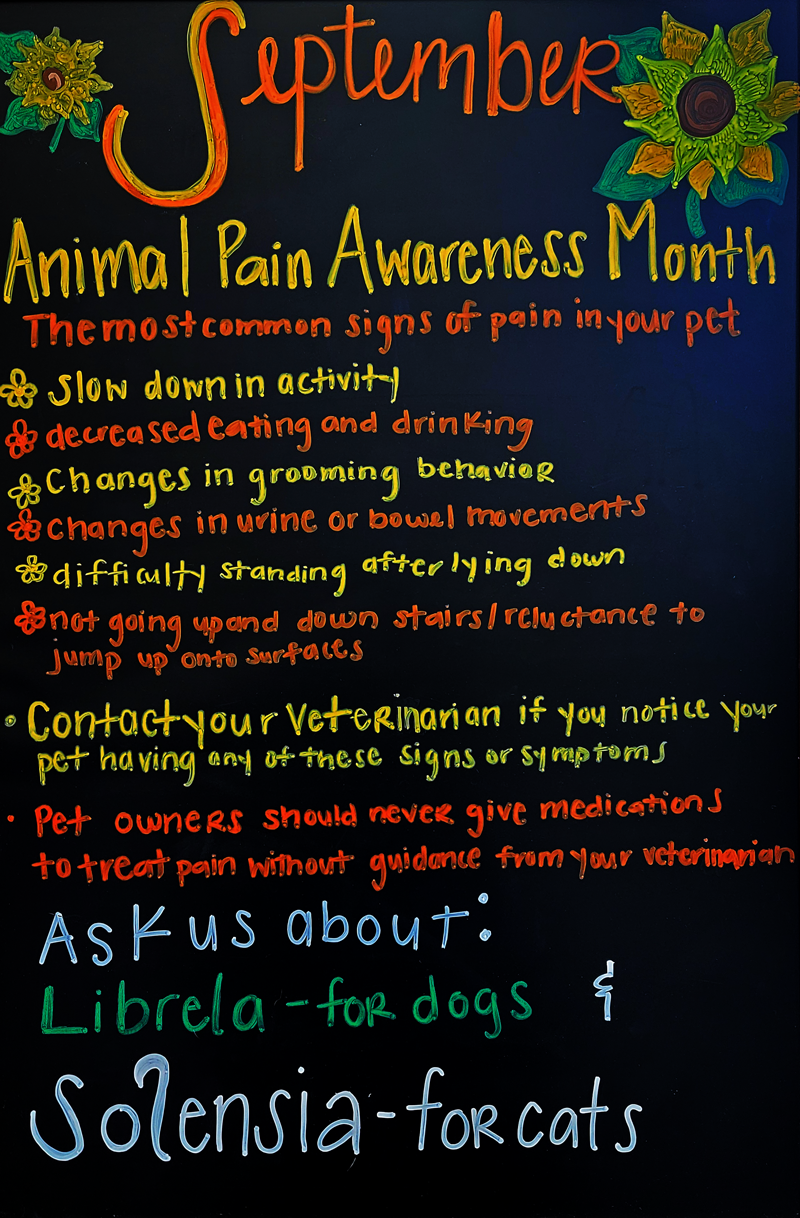
September is Animal Pain Awareness Month
If a pet it suffering from chronic pain, the signs can be subtle. Animals are designed to mask their pain, because a sick animal in the wild is easy prey. Unfortunately, our pets today can hide their pain and prevent getting the care that would help them. Here are six behaviors that are common in pets experiencing pain:
- Your pet’s activity level slows down
- Your pet eats or drinks less
- Your pet changes their grooming behaviors
- There are changes in your pet’s urine or bowel movements
- Your pet has difficulty standing up after lying down
- Your pet stops going up or down stairs/ is reluctant to jump up on surfaces
It’s commonly assumed that some of these pain symptoms are a natural part of “slowing down” as our pets age. But that’s not always true, and your pet doesn’t have to live in pain.
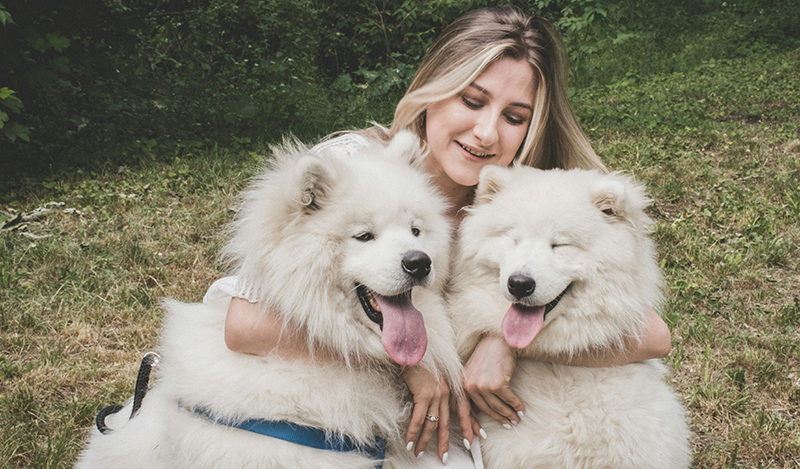
What to Do if You Notice these Common Signs of Pain
The good news? We can often ease a pet’s pain. If you notice your pet showing any of the above signs:
- Contact your veterinarian to share your pet’s symptoms
- Do not give any medications without guidance from your veterinarian. Medications make up half of the Top 20 Pet Toxins in Ohio. Our pets usually require different medications from humans.
- Ask about Librela for dogs and Solensia for cats. These are newer, safer medications that treat osteoarthritis
For more information on a variety of topics, look into our Pet Health Resources. For pet-specific articles, see our All About Cats or All About Dogs information.
Read More
National Food Safety Education Month for Pets
August 28, 2024
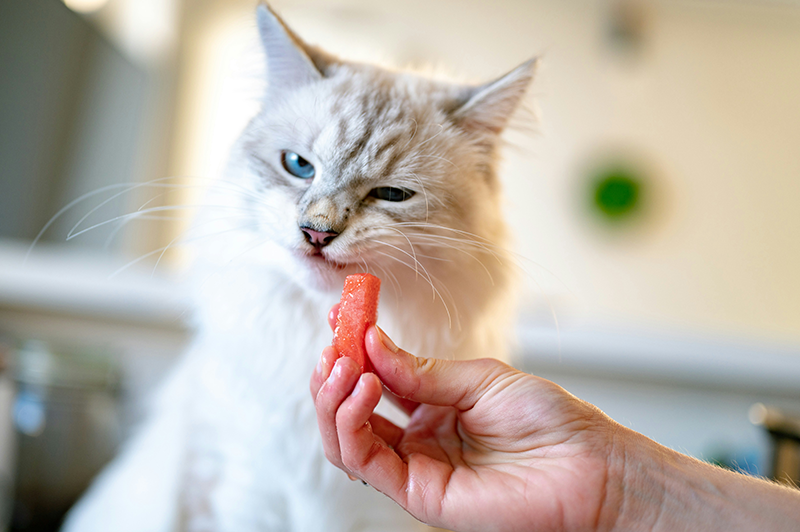
A Guide to Feeding Your Pet Safely
For National Food Safety Education Month in September, we’re shining a spotlight on feeding cats and dogs safely. We’ll cover common toxins, along with the “raw food” trend.
Raw Food Diet: It’s Not Worth the Risk
We’ve shared information about Raw Food Diet for Cats and Raw Food Diet for Dogs before, and our recommendation for both is the same: the risks outweigh any potential benefits. Both dogs and cats face these significant dangers:
- Nutritional deficiencies: With raw food, it’s nearly impossible to give your pet the balance of nutrients they need for good health. Commercially-manufactured pet food actually is formulated for pets’ dietary needs. There’s an important balance between fat and protein, along with nutrients like vitamin A, vitamin D, zinc, copper, taurine, calcium and carbohydrates.
- Foodborne illnesses: We cook raw meat for a reason. From slaughtering to butchering to storage in the grocery store fridge, there’s plenty of opportunity for raw meats to grow dangerous bacteria like Salmonella orListeria monocytogenes. These bacteria can cause serious illness or death in both animals and the people who feed them.
- Choking or punctures: Our modern cats and dogs just aren’t designed to chew and eat raw or cooked bones. Choking and punctured intestines are all too likely and often have tragic results.

Foods that Are Dangerous to Pets
Our furry friends have different nutritional needs than humans, and many foods that are perfectly safe for us can be toxic or dangerous to dogs and cats. We all love to share human food with our pets, but we caution you to keep these ingredients away from your pets in both raw and cooked form.
- Alcohol
- Avocados
- Bones – cooked or raw
- Caffeine
- Candy or gum
- Chocolate
- Garlic
- Grapes
- Green tomatoes
- Marijuana
- Mustard – seeds, powder or the condiment
- Nutmeg
- Nuts
- Onions
- Raisins
- Raw potatoes
- Raw yeast dough
- Sage
- Xylitol – an artificial sweetener
We’d also like to point out that most cats become lactose-intolerant as they age.
We hope this information will help keep your pet safe from food dangers. Check out our Pet Poison Prevention Resources for more information on toxic plants, medications and more.
Read More
National Immunization Awareness for Your Pets
August 12, 2024
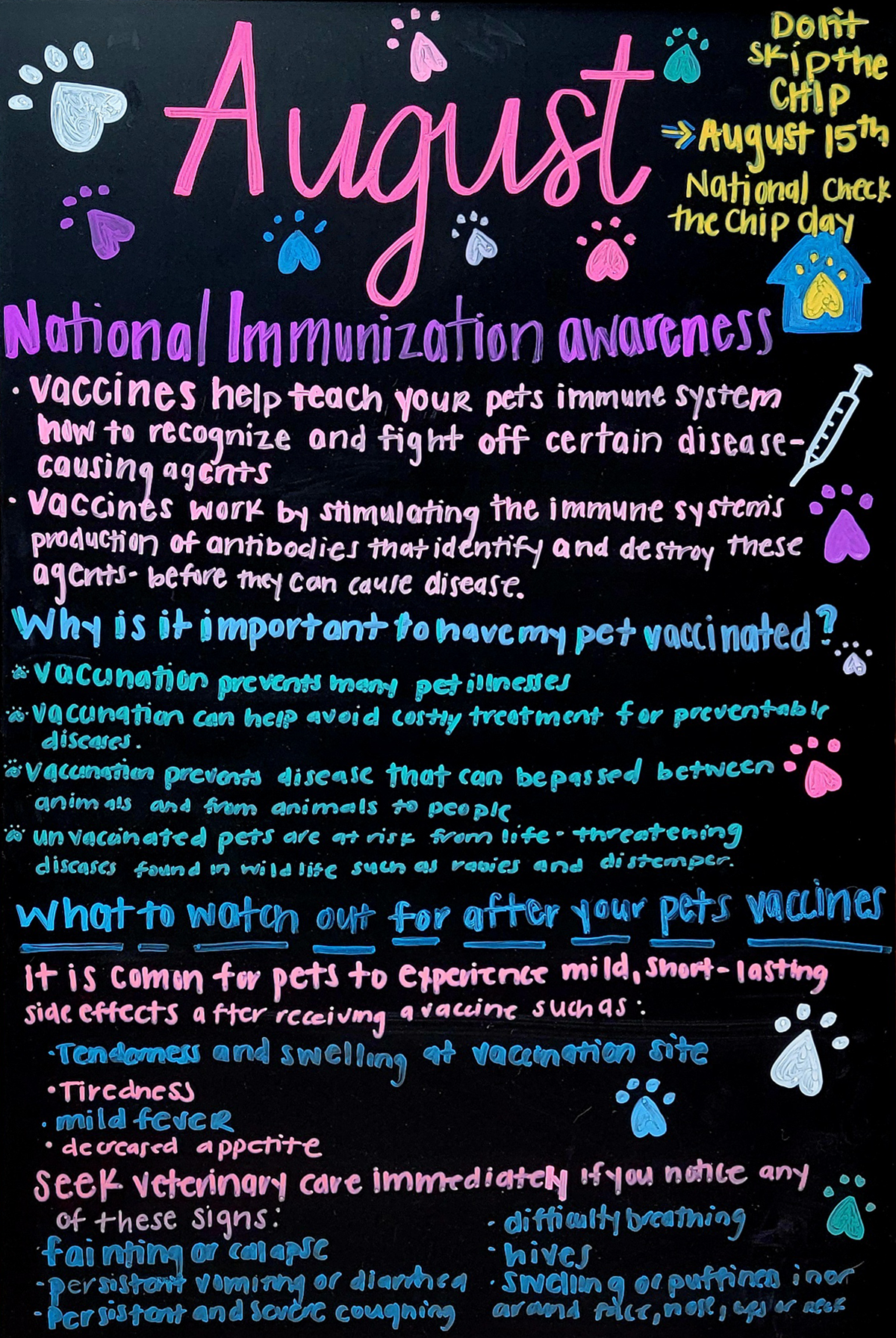
August is a Great Time to Get Caught Up on Pet Immunizations
Let’s kick off National Immunization Awareness month with some information about vaccines for your pet:
- Vaccines help teach your pet’s immune system how to recognize and fight off certain disease-causing agents
- Vaccines work by stimulating the immune system’s production of antibodies that identify and destroy these agents– before they can cause disease
Why is it important to have my pet vaccinated?
- Vaccination prevents many pet illnesses
- Vaccination can help avoid costly treatment for preventable diseases
- Vaccination prevents disease that can be passed between pets and/or farm animals to people (zoonotic disease)
- Unvaccinated pets are at risk from life-threatening diseases found in wildlife, such as rabies and distemper
What to watch out for after your pet’s vaccines
It is common for pets to experience mild, short-lasting side effects after receiving a vaccine, such as:
- Tenderness or swelling at vaccination site
- Tiredness
- Mild fever
- Decreased appetite
Seek veterinary care immediately if you notice any of these signs:
- Fainting or collapse
- Persistent vomiting or diarrhea
- Persistent and severe coughing
- Difficulty breathing
- Hives
- Swelling or puffiness in or around the face, nose, eyes or neck
See our Immunization Resources for more information on vaccines and diseases they prevent, such as heartworm and leptospirosis.
Read More
Know These Fire Safety Steps for Your Pet
July 8, 2024
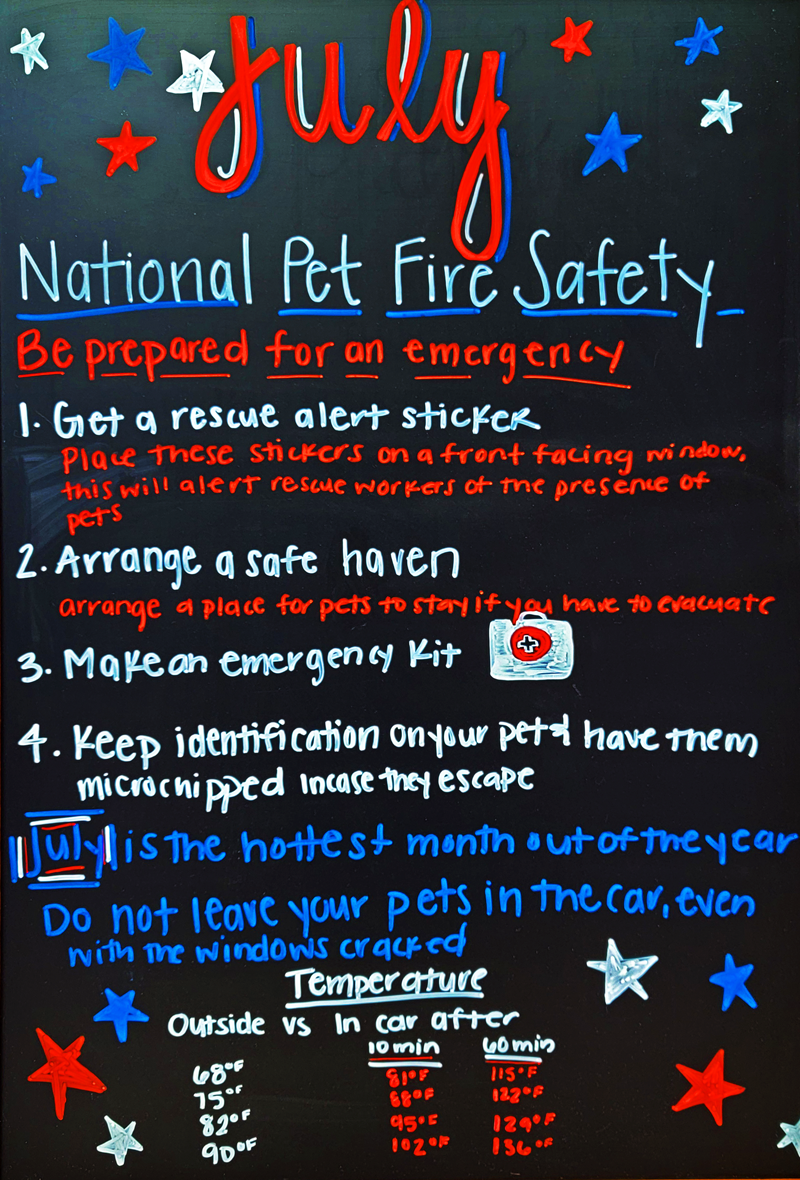
July is National Pet Fire Safety Month
The U.S. Fire Administration keeps statistics on residential fires. For the latest year on record, the US saw 374,300 fires, making this a fairly common danger that everyone needs to plan for.
We especially need to plan ahead for how to rescue and care for our pets in the event of a fire (or any emergency requiring evacuation). Animals won’t know how to safely leave, and they certainly can’t follow a home emergency plan. Here are four pet fire safety tips:
- Get a rescue alert sticker: Place these stickers on a front-facing window or glass door. This will alert rescue workers of the presence of pets. Get one from the ASPCA.
- Arrange a safe haven: Plan for a place for pets to stay if you have to evacuate.
- Make an emergency kit: Include the items your pet needs on a day-to-day basis. See what should be included here.
- Make identifying your pet easy: Keep identification on your pet and have them microchipped, in case they escape during an emergency.
Pet Fire Safety in the News
A recent story out of Colorado Springs highlights that prevention is the best way to ensure pet fire safety. Here are the details:
“Authorities have released a video of a dog starting a house fire by turning on the stove in the middle of the night. The incident happened when a Colorado couple awoke to a high heat alert from their Apple HomePod last week, only to find a fire blazing in their kitchen. Colorado Springs firefighters responded to the fire in the early morning hours of June 26. Investigators discovered the surprising cause of the blaze after reviewing home security footage. The video shows the couple’s curious pup inspecting the stove and accidentally turning it on, which ignited some boxes on top. Fortunately, the owners were able to extinguish the flames, and the man was treated for smoke inhalation.”

Watch the video here.
Thankfully, this incident wasn’t any worse than it was. But watching that dog try to get the food boxes sitting on the stove is scary. It’s a reminder for all pet owners that fire safety is a 24/7 occupation. Of course, those boxes should never have been placed on the stovetop. But what other lessons can we learn and apply in our own homes? Take a walk around your home with your “safety goggles” on and see if you spot any areas for improvement.
For more information, check out “Animal Disaster Preparedness.” Happy July… and stay safe out there!
Read More
16 Basic Steps to Prevent a Lost Pet
July 1, 2024

Summer is the Top Season for Lost Pets.
Keep Yours Safe and Sound
While many of us know that more pets go missing on July 4th than any other day of the year, the entire summer season carries risk for your pet to escape or become lost. People and their pets are spending more time outside, traveling together and hosting gatherings. With these changes in routine, your pet has more opportunity than usual to slip away.
The #1 step you can take for your pet is to get them microchipped and keep your microchip listing up-to-date with current contact information. This advice goes for dogs and cats, alike!
Let’s review 15 other steps to prevent a lost pet this summer.
Prevent a Lost Pet:
5 Steps to Take Outside
Your outdoor oasis is only complete when your pet can safely venture outside with you!
- Check your fences to make sure there’s no place your dog can escape. Our clever canines can sneakily dig holes under the fence, or boards can become loose.
- If your let your cat outside, supervise them. It only takes one accident or predator for a roaming cat to go missing.
- With the rise in coyotes around the Cincinnati area, an invisible fence may present a safety risk to your dog. Plus, some dogs are determined enough to endure the shock and break through the barrier.
- Leash your dog or cat if you’re going to spend time with them in an un-fenced area like the front porch. You never know when something may grab their attention or frighten them, causing them to bolt.
- If there’s a likelihood of fireworks in the area, keep your pets inside, with the doors and windows securely closed.
Prevent a Lost Pet:
5 Steps to Take When Traveling
Vacationing with your pet can be fun for everyone! It’s important to prioritize safety, because reuniting with a lost pet far away from home is especially difficult.
- Put together a car emergency kit for your pet, which includes leash, food, water bowl, water and important medications. An extra leash it important just in case your car breaks down (or your pet has to “go” unexpectedly during the drive).
- Always bring a pet carrier on trips, so you can safely contain your pet whenever your attention isn’t on them, for instance, stopped at gas stations or checking into a hotel.
- Plan for water safety at the beach or on a boat. Put a properly-sized life jacket on your pet, keep them leashed and always supervise them. It’s not uncommon for dogs to go missing around water, and we want to prevent tragedies.
- Don’t leave your pet unattended in a car! Even on a pleasant day, the heat can quickly be fatal. Plus, someone may have rescued your pet while you were away. See our article “Danger Zone: How to Help Pets in Hot Cars.”
- If you’re staying at a rental home with a fenced-in area, thoroughly check for any place your pet might escape. Don’t leave them unsupervised out there, because it’s not a familiar place to either of you.

Prevent a Lost Pet:
5 Steps to Take When Hosting a Party
For many, having friends and family over is a true summer tradition. And the season is filled with holidays perfect for parties. Follow these tips for keeping your pet from escaping in all the excitement.
- Constantly opening and closing doors are a big temptation to cats and dogs alike. Alert guests to watch for your pet and enter and exit quickly, along with firmly closing the door behind them.
- The same advice goes for outside gates. Keep an eye on your gates to make sure they are closed.
- If things get noisy, pets may try to escape the chaos. Give your pets a designated safe place where they can get some peace and quiet. Perhaps make one room of your home off-limits to people.
- Check in with your pet regularly. You’ll be able to gauge their mood and attitude, along with making sure they are still safe.
- If you’re having a difficult time keeping track of your pet, feel free to keep them on a leash by your side. They may also find this comforting.
For more tips on pet prevention, visit our article “National Lost Pet Prevention Month.” And if you’re interested in learning more about microchipping your cat or dog, contact us.
Read More

















